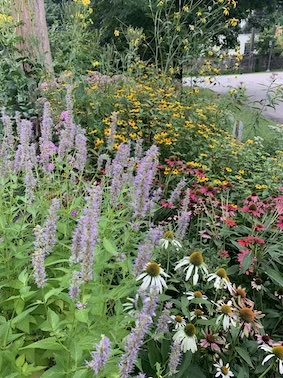Power of Pollinators
Did you know that pollinators are responsible for 1 out of 3 bites of food we take each day? According to the National Park Service, at least 75% of all flowering plants are pollinated by insects and animals. That amounts to 1,200 food crops and 180,000 different types of plants!
Pollinators – bees, wasps, butterflies, moths, beetles, flies, hummingbirds, and bats – are key to a healthy garden. They help spread pollen from flower to flower, which leads to pollination, and more flowers blooming. A high number and range of pollinators is a sign of a healthy ecosystem!
This perennial pollinator garden is a-buzz with insects and birds.
Protecting Pollinators
Without pollinators, plants, animals, and humans could not survive. Unfortunately, habitat loss and pesticide use is threatening pollinator populations across the world. Small actions to create a safe space for pollinators can make a huge difference!
Reduce the Grass
Turf grass (such as Bermuda grass from Africa) consists of just one species or “monoculture” that is exclusively cultivated. Our grass-centric landscape lacks biodiversity and is resource-intensive (such as water, fossil fuels used to maintain the turf, and chemicals such as fertilizers and pesticides) are often used to maintain a weed-free turf lawn.
Pollinator Gardens
Add a sign to inform others about Pollinator Gardens, like this one from Xerces Society.
Creating a pollinator garden is a great way to attract and protect pollinators. Pollinator gardens supply nectar or pollen for a range of pollinators. They also provide food and habitat for animals, help soil stay healthy, and clean the air. Include a sign that educates people about Pollinator Gardens.
According to the National Park Service, the best ways to support pollinator gardens are:
Provide habitat for pollinators with native, nectar-rich flowers (see Eco Regional Planting Guide Cards below)
Offer pollinators a drink with a small, shallow dish of water
Avoid clearing leaves; dead leaves and plant matter provide food and shelter for pollinators
Limit the use of pesticides to avoid poisoning pollinators
Offer a variety of flower types, shapes, and sizes
Plant flowers in large clumps so that pollinators can easily move from one flower to the next
Provide nesting and sheltering sites for pollinators such as downed tree limbs for bees
National Park Service’s Eco Regional Planting Guide for Northeast Region.
Plants Pollinators Love
Wondering what plants will provide the best habitat for pollinators? According to the National Audubon Society, these 10 flowering native plants are a great place to start.
Wild Columbine (Aquilegia canadensis)
Butterfly Milkweed (Asclepias tuberosa)
Turtlehead (Chelone glabra)
Purple Coneflower (Echinacea purpurea)
Blazing Star (Liatris spicata)
Canada Lily (Lilium canadense)
Cardinal Flower (Lobelia cardinalis)
Trumpet Honeysuckle (Lonicera sempervirens)
Beebalm (Monarda didyma)
Woodland Phlox (Phlox divaricata)
For more information on native plants, see Audubon's "Why Native Plants Matter." Small actions to provide shelter, food, and water for pollinators can have a huge impact on ecosystem health. It is time to start supporting the insects and animals that are working hard in our gardens and school grounds everyday! To read more: see this link.
Article by Claire DuBois, Haverford College ‘22, Sustainability Interns at Boyer Sudduth Environmental Consultants.
Printed in PAISBOA’s Friday Flyer Vol. XII, No. 9 - June 2, 2023.






